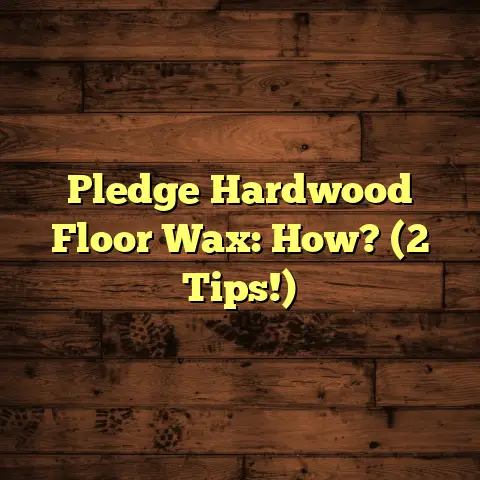How To Fix Popping Laminate Floor?
It’s like a surprise guest showing up at the party—uninvited and loud. That’s how I feel every time I hear a popping sound from my laminate floor. It’s a reminder that even the most well-laid plans can have unexpected hiccups. Over the years, I’ve encountered this issue more times than I can count. But don’t worry; I’m here to share everything I’ve learned about fixing those annoying pops and creaks in laminate flooring.
Understanding the Basics of Laminate Flooring
Before we get into the nitty-gritty of fixing popping laminate floors, let’s briefly touch on what laminate flooring is. While many of you might already know, it’s important to set the stage.
Laminate flooring consists of multiple layers: a core layer made of high-density fiberboard (HDF), a photographic layer that mimics wood or stone, and a wear layer that protects against scratches and damage. This combination provides durability and aesthetic appeal, making it a popular choice for homeowners and contractors alike.
Why Does My Laminate Floor Pop?
Understanding why your laminate floor might be popping is the first step in addressing the problem. In my experience, there are a few common culprits:
- Improper Installation: If the planks are too tight against each other or against the walls, they can create tension that leads to popping sounds when you walk across them.
- Moisture Issues: Laminate is sensitive to humidity and moisture. If there’s a leak or excessive humidity, the boards can swell and then contract, causing noise.
- Subfloor Problems: An uneven or damaged subfloor can lead to instability in the laminate, resulting in popping sounds as you walk on it.
I’ve learned to take these factors into account whenever I encounter this issue.
Step 1: Assess the Situation
Before jumping to conclusions, it’s crucial to assess the area. I often start with a simple walk-through. As I walk, I listen closely for where the sounds are coming from.
- Is it consistent?
- Does it happen in one specific area?
I remember one time when I was working on a residential project; the homeowners complained about noises near their kitchen. After walking through the space multiple times, I pinpointed the popping to a specific section near the sink. This kind of focused observation is invaluable.
Step 2: Identify the Cause
Once I’ve narrowed down the location of the sound, I try to identify what’s causing it. Here are some steps I’ve found helpful:
Inspect for Gaps
Check for gaps between planks or between the planks and the wall. If they’re too tight, that could be your issue. You might be surprised at how often this happens, especially in older homes where settling has occurred.
During one project in an older home built in the 1970s, I noticed that the laminate wasn’t installed correctly. There were visible gaps in some areas while others were so tight that they felt like they were glued together. This discrepancy was causing significant popping sounds.
Check for Moisture
Using a moisture meter can be a game changer. I’ve had instances where moisture problems were hidden under the surface. If you find elevated moisture levels, you’ll need to address that first before fixing the floor.
While working on a property near a beach, I discovered elevated moisture levels due to humidity in the area. The owners had not considered this factor during installation. We had to devise a plan to reduce humidity levels before proceeding with repairs.
Evaluate the Subfloor
If everything looks fine on the surface, it might be time to check beneath the laminate. I’ve had to lift up sections of flooring before to find out that my subfloor had areas that were warped or uneven.
For example, I once worked on a project where the homeowner complained about popping noises throughout their living room. After lifting some boards, I discovered that water damage had caused parts of the subfloor to bow slightly.
Step 3: Fixing the Popping Sound
Now comes the fun part—fixing the problem! Here’s what I typically do:
Adjusting Tight Planks
If your planks are too tight, you might need to remove a few and trim them slightly. This can be a bit of a hassle but is worth it for a quiet floor.
- Remove the Plank: Carefully lift up the planks that are causing issues.
- Trim Edges: Using a saw, trim a small amount from the edges.
- Reinstall: Put everything back together and see if that solves the popping.
I remember one particular job where I had to adjust planks in a dining room after noticing they were snug against each other. After trimming just a quarter-inch along one edge of several boards, the popping noises ceased immediately.
Addressing Moisture Problem
If moisture is an issue, I usually recommend:
- Identifying the Source: Is there a leak? Fix that first.
- Using Dehumidifiers: These can help reduce moisture levels in your home.
In another instance, we found that an old pipe was leaking under the sink, causing moisture to seep into the subfloor. After fixing the plumbing issue and using dehumidifiers for several days, we managed to restore normal humidity levels.
Leveling the Subfloor
For uneven subfloors, self-leveling compound can do wonders.
- Clean the Area: Make sure all debris is removed.
- Mix and Apply Compound: Follow package instructions for mixing and applying.
- Let it Cure: Be patient; give it enough time to set before laying down any laminate.
When I encountered uneven subfloors in a commercial space, this method saved us time and effort compared to replacing large sections of subflooring.
My Personal Experience with FloorTally
When I’m working on flooring projects, I rely on FloorTally for accurate cost estimates and comprehensive project planning. For instance, when tackling a large project where popping floors were just one of several issues,
I was able to input various area types and get realistic budgets generated based on local material and labor rates. It helped me allocate funds effectively without worrying about unexpected costs sneaking up on me.
Using FloorTally saved me hours of calculations—I remember working on a large community center project where we needed precise estimates for both materials and labor costs. By inputting different variables into FloorTally, we were able to create an easy-to-read report that helped us stay on budget while addressing various flooring issues simultaneously.
Tips for Prevention
Once you’ve fixed those pesky pops, it’s good to think about prevention.
Acclimate Your Flooring
Before installation, always acclimate laminate flooring to the room’s temperature and humidity for at least 48 hours. This helps prevent future popping sounds due to expansion and contraction.
I always stress this point to clients because it makes such a difference in long-term performance. During one installation in a home with lots of windows and sunlight exposure, we took extra care to acclimate before laying down any boards—and it paid off with zero complaints!
Use Underlayment
I always recommend using a good-quality underlayment. It can absorb some sound and provide cushioning that helps prevent popping.
In several projects where we used underlayment, clients reported fewer issues with noise over time compared to similar installations without it.
Regular Maintenance
Keep an eye on your humidity levels and address any spills or leaks immediately. Keeping your floors clean can also help maintain their integrity.
During my regular check-ups with clients after installation, I often remind them about simple maintenance tips like promptly cleaning up spills or checking for leaks periodically.
Case Studies: Real-Life Experiences
To give you some more context around these solutions, let me share a few case studies from my experiences fixing popping laminate floors.
Case Study 1: The Old Bungalow
In an old bungalow built in 1920, I was called in by homeowners who were frustrated with popping noises throughout their living room after installing new laminate flooring.
Upon inspection, it became clear that:
- The subfloor was uneven due to settling over decades.
- The laminate boards were installed tightly against walls without expansion gaps.
After lifting up sections of flooring and leveling out the subfloor with self-leveling compound, we also added expansion gaps along all edges during reinstallation. The result? A quiet floor and satisfied homeowners!
Case Study 2: The Beach House
I took on another project at a beach house where moisture was an ongoing concern due to high humidity levels in summer months. Homeowners noticed popping noises after just one year of installation.
After using a moisture meter to check levels under laminate flooring:
- Elevated moisture readings indicated that humidity had indeed been affecting board performance.
We took measures by installing dehumidifiers and ensuring proper ventilation in crawl spaces beneath their home while also educating them on maintaining humidity levels throughout seasonal changes.
This proactive approach not only fixed current issues but prevented future problems from arising altogether!
Case Study 3: The Commercial Space
In a commercial space—a small boutique—I faced multiple complaints regarding popping sounds near fitting rooms after new laminate flooring was installed.
After analyzing:
- The installation process revealed improper acclimation prior to laying down boards.
- Additionally, we noticed that foot traffic patterns led to excessive wear over time.
We worked closely with management to implement an acclimation period before replacement while also considering alternate underlayment options designed specifically for high foot traffic areas—resulting in drastically reduced noise complaints afterward!
Conclusion: Moving Forward with Confidence
Fixing popping laminate floors doesn’t have to be daunting. With careful assessment and some straightforward fixes, you can enjoy a quiet home once again.
While challenges will arise—like realizing that pesky moisture issue is coming from a hidden leak—remember that each obstacle you overcome adds to your expertise as a homeowner or contractor.
By sharing my experiences and insights through real-life examples, I hope you feel more prepared to tackle your own flooring issues with confidence.
Whether you’re dealing with moisture problems or ensuring proper installation techniques are followed—know that help is available! Each step taken makes all those little pops seem less overwhelming while providing lasting peace of mind for years ahead. Happy fixing!





